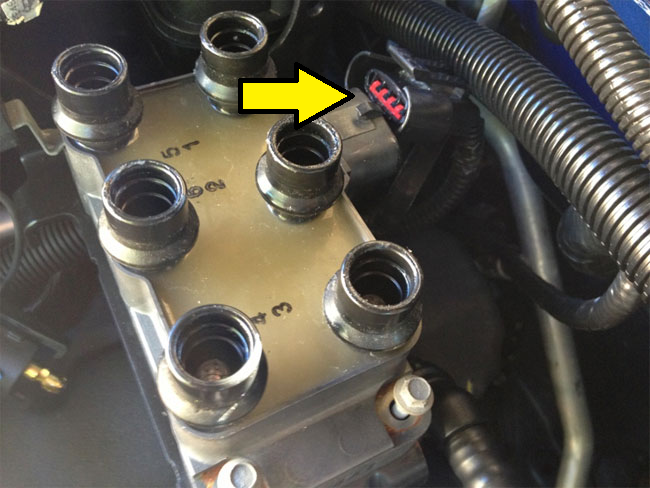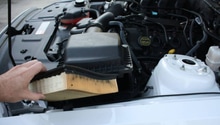Ford Mustang V6 1994-2004: Symptoms of Coil Pack Failure
A common problem on the 1994 to 2004 Mustang V6 models is that the ignition coil pack is prone to failure and can lead to rough running, poor idle, and an unsightly check engine light. Fortunately, a faulty coil pack can be quickly diagnosed and easily replaced.
This article applies to the V6 Ford Mustang (1994-2004).
By the early 1990's, the traditional ignition system consisting of an individual ignition coil coupled with a distributor was being phased out by Ford, and their new Mustangs were coming with a state-of-the-art electronic ignition system. In layman's terms, an electronic ignition system utilizes the inputs from various engine sensors to inform the computer when to fire the ignition coils to produce spark for combustion. The electronic ignition system is often praised for its improved engine control, reduction in emissions, and ease of maintenance. While the electronic ignition system is quite robust and is generally reliable, the coil pack fitted to the V6 Mustang is one of the few components that has been known to fail and cause engine performance issues. Fortunately, a failed coil pack can be easily tested and replaced to restore function to the ignition system and fix a rough running condition. This article will give an overview of the symptoms, common questions, and troubleshooting procedure associated with a coil pack failure on the 1994 to 2004 V6 Ford Mustang models.
Component Breakdown
Coil Pack
The coil pack on the V6 Mustang is composed of three individual coils that are connected together to form a single unit or "pack." The coil pack is controlled by the PCM (powertrain control module) to deliver spark to the individual cylinders upon request. The coil pack eliminates the need for a traditional distributor and coil ignition system.

Figure 1. Typical coil pack for V6 Mustang models. 
Figure 2. Coil pack location in engine bay.
Troubleshooting
Testing the condition of a coil pack is a straightforward job that can be quickly completed at home. Before beginning, ensure that all spark plugs are in good usable condition. A bad spark plug may be causing a rough running engine or engine misfire that is misinterpreted as a bad coil pack. Similarly, check that all spark plugs wires are fully seated on the spark plugs and coil towers, as a disconnected plug wire could be causing the engine misfire.
Test for Spark at Spark Plugs
The quickest and easiest way to determine if the coil pack is operating correctly is to test for spark at each spark plug. Remove one spark plug wire at a time and attach it to an HEI spark tester or old spark plug. While having a friend crank the engine, look for an electrical arc at the tester/plug. Do not be alarmed if the engine starts. Continue to test for spark at each cylinder.

Test for Spark at Coil Pack
If one or more spark plugs did not fire during the previous test, proceed with testing for spark at the coil pack to eliminate the possibility of a bad spark plug wire. Remove the plug wires from the coil pack and place an HEI tester/spark plug at each terminal while cranking the engine as before. If there is no spark at any coil tower, there is likely a problem with the PCM, ignition module, or fuse/relay. A spark at only one of the coil towers is indicative of a bad coil pack and should be replaced. If all coil towers produced spark, the problem is a faulty spark plug wire.

Test Coil Pack
If there is no spark at any of the coil towers, a digital multimeter and test light can be used to determine if the coil pack is faulty or if the problem lies elsewhere.
- Unplug the electrical harness plug from the coil pack. Using your test light or multimeter, test for voltage at the power pin of the electrical plug while a friend cranks the engine. If there is power at the plug, the coil pack is receiving power and the problem is likely within the coil pack instead of the PCM, fuses, relays, or crank position sensor.

- Each coil can be tested for resistance by connecting the multimeter across the ignition coil power pin and each individual coil pin. Connect one end of the multimeter lead to pin #4 (power) and the other lead to one of the coil pins (C1, C2, C3). The resistance should measure between 0.3-1.0 ohms. If the measured resistance is out of specification at any one of the coils, the coil is likely bad and the coil pack should be replaced.

Scheduled Maintenance
With distributor-less ignition systems, it is not uncommon for a coil pack to degrade and fail at 50,000 miles or sooner. That being said, many owners have 100,000+ miles on their original coil pack without issues. Generally, a coil pack is not replaced at a regular maintenance interval, but only when it begins to fail and cause engine performance issues.

Common Questions
What causes coil pack failure?
As with most components, coil packs tend to breakdown and wear out with use. Usually, worn spark plugs or spark plug wires with excessive resistance will cause the coil pack to be over-worked to provide the proper voltage for ignition to occur. In turn, the continuous heat buildup and strain on the coil pack can lead to failure. Similarly, it is not uncommon for coil packs to split or crack as seen in Figure 7.
What are the symptoms of coil pack failure?
The most common symptom of a coil pack failure is an engine misfire while the engine is under load (typically during acceleration); however, any of the following conditions may be a sign that the coil pack is bad.
- Check engine light and misfire codes (P0300-P0306 for OBD II equipped vehicles)
- Rough or inconsistent idle
- Poor fuel economy
- Excessive tailpipe emissions
- No start condition (if complete coil pack has failed)
Can I replace only one coil at a time?
Unfortunately, the coil pack is a sealed assembly of coils that cannot be replaced individually. If coil pack replacement is necessary, it is an opportune time to upgrade the coil pack as many aftermarket manufacturers produce coil packs that exceed the performance of the original unit.
Should I replace spark plugs and wires when installing a new coil pack?
Yes! It is highly recommended that new spark plugs and spark plug wires are installed when replacing the ignition coil pack. This will ensure that the new coil pack is not being overly stressed by old plugs or wires that could potentially lead to premature coil failure.
Related Discussions
- Symptoms of Intermittent Coil Pack Failure? - MustangForums.com
- Coil Pack Help - MustangForums.com
- No Spark to Two Cylinders from Coil Pack - MustangForums.com






